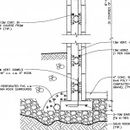Sewer under footing
I am an owner builder, we purchased a property with the foundation already in place. The sewer and water are at the lot line. Footing is on compacted crush with bedrock beneath.
Looking for help with the process of bringing the services under the footing, complications with undermining? Options to complete this securely?
Many thanks!
GBA Detail Library
A collection of one thousand construction details organized by climate and house part










Replies
Paul,
Dig under the footing, place the sewer line and another 3" PVC pipe for the waterline to go through. Cover the sewer line with pipe insulation or other flexible foam, and fill the hole with a slurry of concrete.
Sometimes you can use directional drilling for something like this, but you have to be careful it only makes sense if you have at least maybe 100 feet or so of sewer line to run.
I usually recommend against installing lines with directional drilling under foundations since you can get erosion that remains hidden. In your case, if you’re just popping through to the inside, you’ll be able to see under the foundation from the hole you dig next to it so you’ll know if you have to compact anything.
There is nothing wrong with Malcolm’s suggestion, but you can avoid trenching outdoors if you use directional drilling. Directional drilling just needs a bore pit at the ends. The downside is it’s expensive, but sometimes that cost is more than offset by the elimination of grounds restoration after trenching.
Bill
My opinion you should replace the old sewer if you see clay tile or iron. Replace it all the way to the main. If the pipe you found is plastic I would have the old drain inspected with a video camera all the way to the main before considering reusing it.
In the city of St Louis part of the work required of the company demolishing a house is to block the old sewer drain as close to the main as possible. This is done in an effort to keep storm water from collecting in the old foundation and draining thru the old pipe into the sanitary sewer. They have a problem with the sanitary overflowing when it rains.
It is a good idea to separate the water supply from the sanitary drain by 6 feet to prevent contamination of the water supply most cities will want to see separate trenches when they inspect.
I would also be reluctant to reuse the old water supply you cannot be sure the old pipe does not have a section of lead pipe or joints. Old houses tended to have fewer bath rooms and could get by with a smaller main pipe. Over time old pipes often build up a scale on the inside of the pipe restricting the flow of water.
Walta
How does your grade fit into the picture? Is going under the footing your only option? Are you installing a bathroom in your basement? Realize there is quite a load on your footing, which is what it is for, so installing a pipe under it may create some issues. Not to mention that is where your drainage will be and it may settle, move or distort over time.